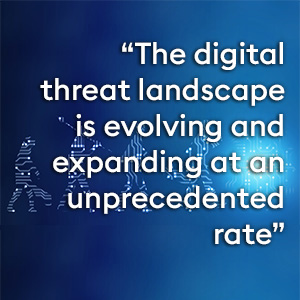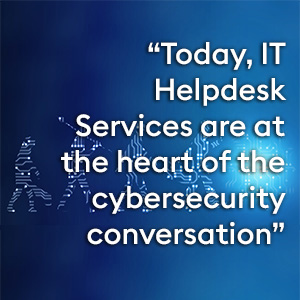How Cybersecurity is Reshaping the Role of IT Helpdesk Services
Just as the business world has gone through a significant transformation in recent times, so too have IT Helpdesk Services, as their role has quietly but fundamentally shifted. No longer merely the troubleshooters of technical glitches, they have emerged as the often-unsung vanguards of cybersecurity.
This article, drawn from the trenches of IT management and cybersecurity defence, aims to unravel how the IT Service Desk is now not just expected to respond to, but to actively reshape, the cybersecurity landscape.
What follows is both an examination of threats and protocols and a blueprint for ensuring that your IT Helpdesk Services can now be a proactive, strategic asset for safeguarding your company’s digital frontier.
A New World of Cybersecurity Threats and Vulnerabilities
 The digital threat landscape is evolving and expanding at an unprecedented rate, with sophisticated external dangers and insider threats becoming a serious concern for businesses across the globe. IT Help Desk teams are rapidly becoming an important frontline defence mechanism, often confronting these threats on a daily basis.
The digital threat landscape is evolving and expanding at an unprecedented rate, with sophisticated external dangers and insider threats becoming a serious concern for businesses across the globe. IT Help Desk teams are rapidly becoming an important frontline defence mechanism, often confronting these threats on a daily basis.
While not an exhaustive list, below are a few of the threats and vulnerabilities your Help Desk will likely be faced with:
- Sophisticated phishing scams. Phishing has moved beyond simple deceptive emails to include far more advanced scams that are harder to detect. These may involve highly personalised emails, text messages and even voice messages. IT Helpdesk Services can help to educate users on how to identify such scams for themselves, underscoring the importance of vigilance and ongoing cybersecurity training.
- Remote Worker Vulnerabilities. The sheer number of people who became home workers for the first time during the pandemic in 2020 overwhelmed most companies’ ability to adequately educate their staff on the cybersecurity measures they should be implementing as good practice in their home workspace. Cybercriminals have increasingly looked to exploit this security weakness to gain access to corporate networks. Cybersecurity training and Endpoint Detection and Response (EDR) security software are good starting points for filling the holes in your digital protection grid.
- Outdated Software Weaknesses. Put simply, the older your software is the greater the exposure you could be suffering from – chinks in your cybersecurity armour could leave you vulnerable to ransomware attacks and data breaches. Your IT Helpdesk should be ensuring that software updates are regularly reviewed, and they’re there to help deal with the fallout of any failure to do so.
- Internet of Things (IoT). As companies move ever more rapidly towards an interconnected world, where systems speak with one another without human intervention to streamline and speed up predictable, repetitive tasks, the whole system can become impacted by a single third-party vulnerability. Once again, regularly updated software and secure Internet connections are an important part of the solution, as is having the technical skills available to you to identify an issue swiftly so its impact can be limited.
- Internal Threats. Not all threats come from outside of your organisation – some come from your own staff. These may be errors, mistakes, or thoughtlessness, or they could be malicious in intent. Protection here is often about a close monitoring of permissions and access, but once again, proper training of staff on what to watch out for and report is key to help your IT Help Desk team jump into action and save the day.
Essentially, your IT Desk Help plays a crucial role in implementing and overseeing the security protocols for your company’s devices, ensuring they remain protected regardless of where work is being done, that software is regularly updated to prevent unpatched systems being exploited by cybercriminals, and strategically planning for almost any situation, mitigating potential future vulnerabilities.
The Evolving Role of the IT Service Desk
 Gone are the days when the IT Help Desk was solely focused on troubleshooting hardware issues and managing software installations. Today, IT Helpdesk Services are at the heart of the cybersecurity conversation, tasked with not only resolving technical issues but also protecting against and responding to ever-more sophisticated cyber threats. This expanded role will now include some or all of the following:
Gone are the days when the IT Help Desk was solely focused on troubleshooting hardware issues and managing software installations. Today, IT Helpdesk Services are at the heart of the cybersecurity conversation, tasked with not only resolving technical issues but also protecting against and responding to ever-more sophisticated cyber threats. This expanded role will now include some or all of the following:
- Education. The IT Help Desk plays a role in demystifying cybersecurity, transforming employees from potential weak points in the security infrastructure into informed users who can recognise and skilfully sidestep potential threats. This empowerment not only fortifies individual awareness but collectively improves the organisation’s defence against cyber intrusions.
- Security Response. Acting as the organisation’s cybersecurity first responders, the IT Help Desk rapidly responds to incidents, mitigates risks and always looks to minimise damage. Their efforts and successes ensure business continuity and ultimately safeguard your organisation’s reputation.
- Protection Policy Enforcement. By rigorously enforcing data protection policies, your IT Help Desk serves as the backbone of the company’s compliance efforts. This diligence ensures adherence to regulatory standards, protecting the organisation from potential legal and financial repercussions.
- Threat Monitoring. Continuous surveillance for potential cybersecurity threats allows the IT Help Desk to pre-emptively identify and neutralise risks before they have a chance to cause trouble. This vigilant oversight ensures the integrity and security of the organisation’s digital assets.
- Security Software Oversight. IT Helpdesk Services ensure that all security software is optimally configured, updated, and functioning as intended. This oversight is crucial for maintaining a robust defence against malware, ransomware, and other common cyber threats.
- Access Control. Managing access control ensures that only authorised individuals can view sensitive information or access to the organisation’s network. This gatekeeping role is pivotal in preventing unauthorised access and potential data breaches.
- Software Patch Management. By keeping software up to date with the latest patches, the IT Help Desk eliminates vulnerabilities that could be exploited by cybercriminals. This proactive approach significantly reduces the organisation’s exposure to cyber threats.
- Device Configuration. Setting up and maintaining the security configuration of all devices on the company network prevents unauthorised access and ensures data integrity. This foundational security measure protects against a wide array of digital threats.
- Security Best Practices Guidance. The IT Help Desk provides guidance on security best practices, advising on secure setups for remote work, password management, and more. This guidance creates a more secure work environment, regardless of where an employee works from.
- Emerging Threat Planning. By staying abreast of emerging cybersecurity threats and trends, the IT Help Desk prepares the organisation for future security challenges. This strategic thinking ensures that the company remains resilient in the face of evolving commercial dangers.
Empowering the IT Service Desk
You can play a role in boosting the effectiveness of your IT Helpdesk Services. If they are an in-house team, they will require robust tools and continuous training in the latest cybersecurity trends and defence mechanisms. If you outsource this function then it’s important to ensure that your workforce appreciates not only the role and purpose of the IT Help Desk, but their role as vital cogs in the cybersecurity machine and the importance of vigilance and observance, of reporting and absorbance of guidance, essentially fostering a culture of cybersecurity awareness.
Looking to the Future
 As we look ahead, the integration of artificial intelligence (AI) and machine learning will further empower IT Help Desk services. They promise to streamline operations, predict potential security threats, and offer insights to refine cybersecurity preventative and response strategies. Nevertheless, the human element remains irreplaceable, with IT Help Desk professionals playing an indispensable role in interpreting data, managing workforce relationships, and championing a secure organisational culture.
As we look ahead, the integration of artificial intelligence (AI) and machine learning will further empower IT Help Desk services. They promise to streamline operations, predict potential security threats, and offer insights to refine cybersecurity preventative and response strategies. Nevertheless, the human element remains irreplaceable, with IT Help Desk professionals playing an indispensable role in interpreting data, managing workforce relationships, and championing a secure organisational culture.
Cybersecurity is no longer an IT issue but a strategic business imperative. Through recognising and supporting the critical role of your IT Helpdesk in cybersecurity you can ensure that your organisation is not only protected against current threats but prepared for future challenges.
For more information on Cybersecurity and IT Helpdesk Services contact Assembly Managed Services.
Telephone: +44 (0)20 3795 6880
Have you enjoyed this blog? If so, why not share it on your preferred social media platform?






